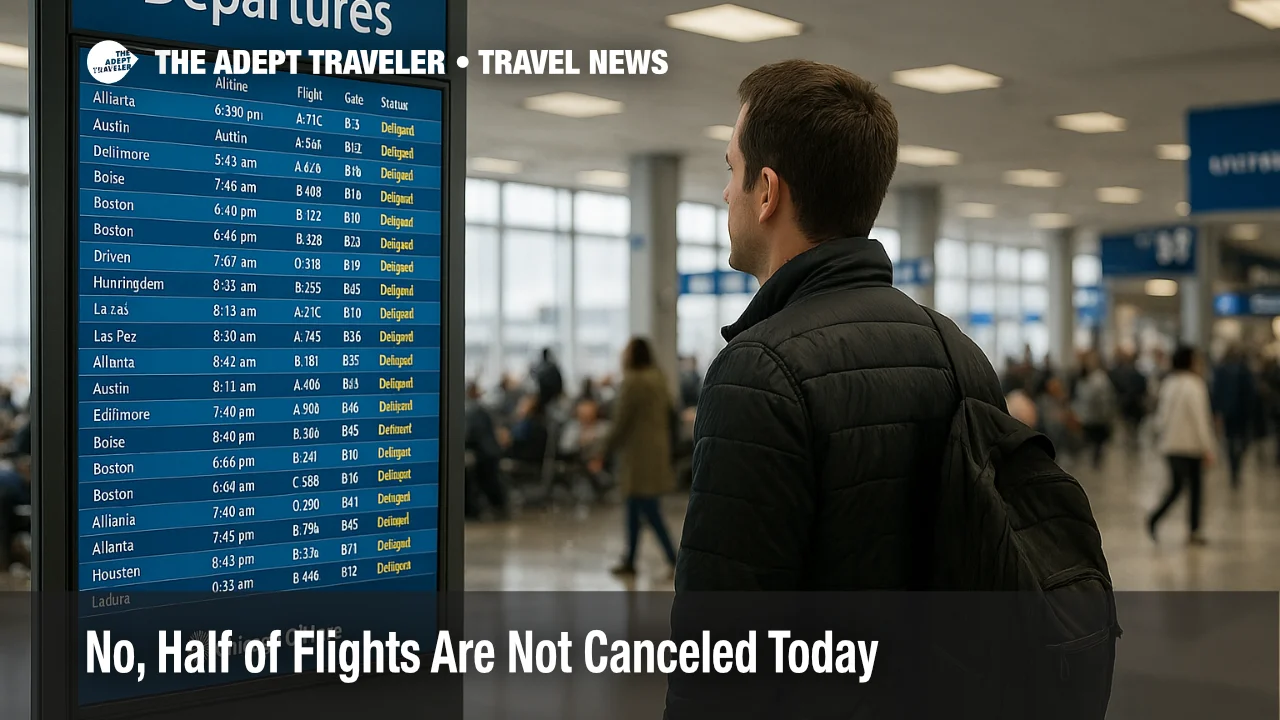No, Half of Flights Are Not Canceled Today

Key points
- By midafternoon, FlightAware showed about 2,000 U.S. cancellations and roughly 6,000 delays, elevated but not a majority of operations
- FAA baseline averages about 44,000 flights per day, so today's disruptions are far below fifty percent
- FAA ordered phased traffic trims at 40 airports, starting near 4 percent with potential increases if staffing does not stabilize
- Weekend delays reflect compliance with the cap and rotation recovery, not a system collapse
- Travelers should compare live dashboard totals to FAA daily volume and focus on their departure airport and time bank
Impact
- Recheck Status Often
- Verify your flight repeatedly on day of travel, then again two to three hours before departure for gate or timing changes
- Protect Connections
- Move to an earlier bank if you have a tight connection at a managed airport and leave generous buffers
- Use Airline Tools First
- Try same day changes in the airline app, then call centers as backup when queues spike
- Watch Managed Airports
- Expect rolling delays at the 40 airports under FAA trims and confirm any waivers before you switch flights
- Keep Perspective
- Totals can look big in isolation, but they remain well short of half when set against the FAA daily baseline
A viral claim that more than half of U.S. flights are canceled or seriously delayed today is false. By midafternoon, FlightAware showed roughly 2,000 cancellations within, into, or out of the United States and about 6,000 delays, a rough day, but nowhere near fifty percent of operations. Compare any live totals to the FAA's daily volume to keep proportion.
The numbers can look large without context. The FAA's public dashboard says the system handles about 44,000 flights on an average day, so even bad days during the current trims fall far short of half of operations.
What is driving the disruption
The FAA directed airlines to reduce traffic at forty busy airports because of the federal shutdown and staffing strain, phasing cuts that began near 4 percent on Friday with the option to climb if conditions warrant. Agency briefings and reporting outline the plan and hubs involved, with officials signaling potential increases toward 10 percent next week if staffing does not stabilize.
The weekend pattern reflects those controls, not a collapse of the system. Cancellations rose as carriers complied with the cap and rebuilt rotations, which pushed delays higher, especially at the largest hubs, but still far from a majority of flights nationwide.
How to read the daily stats the right way
Live dashboards can be alarming without a baseline. FlightAware's cancellations page lists global totals and U.S. only totals, and its Misery Map helps spot outlier airports in real time. Compare those against the FAA's average daily flight count, then zero in on your specific departure airport and bank to assess your real exposure. If you need a quick rule of thumb, divide U.S. cancellations by roughly 44,000 to gauge proportion, then check whether delays are concentrated at an airport you use.
Background
Air traffic control, ATC, staffing has been strained during the shutdown, so the FAA is using traffic management reductions to preserve safety margins while airlines adjust schedules. Third party coverage tracks the phased caps by date and airport, while the agency's own pages and daily planning reports describe how disruptions propagate through banks and rotations.
Practical advice for travelers
Check flight status repeatedly on the day of travel, then again two to three hours before departure for any gate or timing changes. If you have a tight connection, move to an earlier bank, especially through one of the forty managed airports named in current coverage. When irregular operations hit, use your airline app first for same day changes, since inventory there often refreshes before call centers can help.
Final thoughts
Today's disruptions are real, and planning buffers is smart. The claim that more than half of flights are canceled or seriously delayed is not supported by live data or by the FAA's current reduction plan. Keep perspective, verify with airline tools and FlightAware, and build conservative connection windows until the FAA lifts traffic trims.
